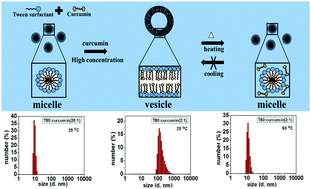Introducing Tween-curcumin niosomes: preparation, characterization and microenvironment study†
Abstract
In this work, we report unusual niosomes (non-ionic surfactant based vesicles), prepared using non-ionic surfactant Tween 80 (T80) as well as Tween 20 (T20) and curcumin. Conventional niosomes consist of non-ionic surfactant and cholesterol. We found that, despite being a probiotic, curcumin plays a similar role to cholesterol in the formation and stabilization of niosomes. The prepared Tween-curcumin niosomes were characterised using Dynamic Light Scattering (DLS), zeta potential, Scanning Electron Microscopy (SEM), Atomic Force Microscopy (AFM), and Transmission Electron Microscopy (TEM) techniques. The curcumin-induced micelle to vesicle transition in the Tween surfactants was investigated by DLS, zeta potential, fluorescence anisotropy, and fluorescence lifetime studies. At room temperature (298 K), the prepared niosomes were found to be stable; however, at a higher temperature (333 K), the niosomes degrade gradually and irreversibly to form micelles. The temperature-dependent vesicle to micelle degradation was monitored using fluorescence anisotropy, absorption, DLS and Differential Scanning Calorimetry (DSC) measurements. Further, the Tween-curcumin niosomes show a controlled release of curcumin, which could open up the possibility of multidrug therapy.



 Please wait while we load your content...
Please wait while we load your content...